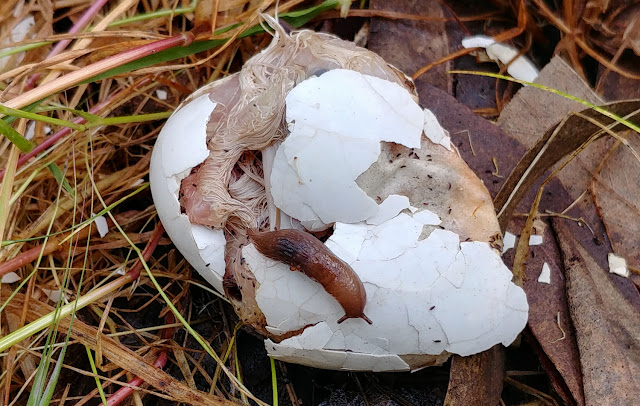As of today, 15th, there has been 104 mm of rain in the Canberra area in November. 48 mm fell in the previous four days with 30 mm on the wettest day, the 11th. And it has been very windy, with gusts of over 40 km/h each day, peaking at 65 km/h on the 14th. So these have been testing times for birds with chicks, like this Tawny Frogmouth who was covering two chicks during the rain.
This other frogmouth had his chicks tight beneath him. One is right beneath his belly, its tail and wing tips are protruding towards the camera, and its sibling is tucked under his breast feathers, face to the camera. The chicks are at a difficult age to protect from the rain. Their flight feathers are well formed, but their bodies are still mostly downy. If the down becomes wet they can become chilled and die.
This chick's body was lying below another nest, where the adult was still brooding two chicks. It must have been too difficult to cover three large chicks adequately. This chick died when about 18 days old. They fledge at about 28 days.
And at another nest, this chick died while trying to hatch. Perhaps the adults were intent on covering its siblings and so sat tight through the rain and wind, possibly too tight, and the chick could not push the shell open. It had opened the shell, as can be seen by the crack line around the top, but never left the egg. So close. The chicks bill can be seen above the slug - whose presence is an indicator of how wet the weather was.
I found this Brown Goshawk chick lying freshly dead below a nest in the same wood as the last frogmouth nest. It was not yet stiff with rigor mortis, nor found by ants, and it had been very windy earlier in the morning. The chick had a partially filled crop, as can be seen by the bulge in its throat, so the adults had been providing enough food. Wind blow was the most likely cause of death. There was still at least one other chick in the nest and the adult female was in attendance, looking after it.
The goshawk nest was set at the end of a slim high branch and it was bouncing about in the still brisk wind. The female was quick to return and protect any chicks in the nest as soon as I left the area.

I found two hatched goshawk eggshells below a tree where the adults frequently perch. There were lots of droppings below, that indicated this. And the adult female would have taken the eggshells from the nest and dropped them there. In the above shot, the cup-shaped membrane of the bottom half of a shell indicates where the chick had cut its way around the egg, then lifted the lid and popped out.
This lid of a goshawk eggshell shows the chip marks where the chick had pecked with its egg-tooth to prise open the shell. The pattern is similar to that around the frogmouth eggshell.
Young birds are so vulnerable to the weather.








No comments:
Post a Comment